Chicken and Shrimp Gumbo
Christey and I started blogging about food on LiveJournal, just as a fun way to shoot what we would occasionally have for dinner. When I decided to step up my cooking, and Christey decided to step up her food photography, we realized we needed something a little more robust than LJ. We moved to WordPress's site, then eventually to our own server using WordPress software. One year ago on April 1st, we bought the domain FotoCuisine.com (PhotoCuisine.com was taken, ironically on several levels, by a French company) and linked it to our WordPress site. The lines of where our food blogging started are a little blurry, but buying the domain is a pretty good line in the sand, so welcome to the second year of FotoCuisine! Christey and I thank you very much for your support, comments, links, suggestions, and all-around fellow-foodieness!
-----------
When I lived in Atlanta, I made a lot of gumbo. I haven't made it in a while, though, and when I saw Top Chef's New Orleans episode a few weeks back, I told myself I had to make it again soon.
There are factions within the gumbo world that I don't pretend to fully comprehend. Just like wet vs. dry barbecue, if your family hasn't made their particular version for a century or so, you're pretty much dismissed to the sidelines of the argument. One of the biggest gumbo controversies is okra vs. file as a thickener. Personally, I annoy both sides, because I like both about equally. But, when I make it myself, I almost always use file. And, when you get right down to it, the thickener isn't really what makes gumbo a good gumbo. If there's any agreement at all about gumbo it's this one fact: it's all about the roux.
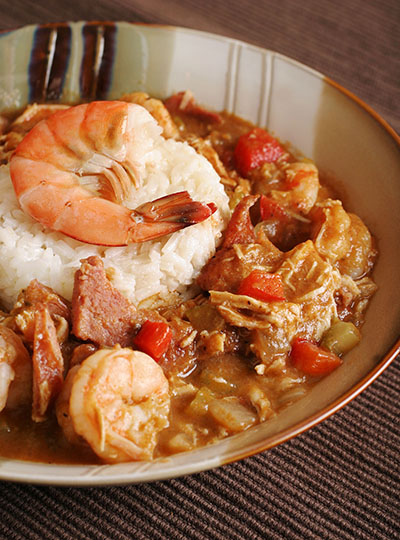
The French mirepoix is usually understood to be onion, celery, and carrot, diced. The actual term mirepoix refers to the size of the dice -- about the size of your thumbnail -- not the ingredients. Many chefs now consider that to be overly pedantic, to the point where "chop a mirepoix finely" is no more of an oxymoron than "jumbo shrimp". In any case, hot and swampy Louisiana never had the carrot production of Europe, or perhaps it was just personal taste, but the "trinity" of Louisiana cooking is onion, celery, and bell (sweet) pepper, with the usual personal modifications. I like to use red pepper instead of the green, partially for the more complex flavor that I love in most ripe vegetables, and partly due to the wonderful color combination.
For this gumbo (about four servings), I used half of a huge bell pepper, half an onion, and two cleaned celery stalks, cut into a dice about a pinky-nail size. The ratio is roughly the same amount of onion as pepper and celery together (a 2:1:1 ratio).


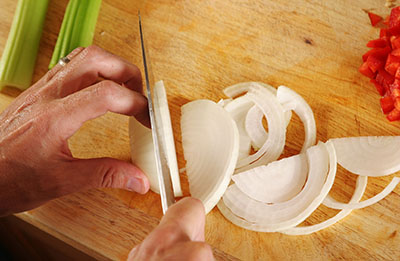

Once the veggies were diced, I took a link of fresh andouille sausage and sliced it on a bias, then halved the slices.

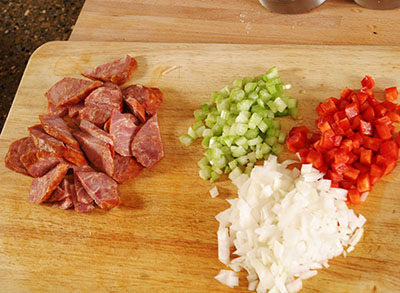
I'm going to shred the chicken, so I took a chicken breast and almost poached it in barely-simmering salted water until it was cooked through.
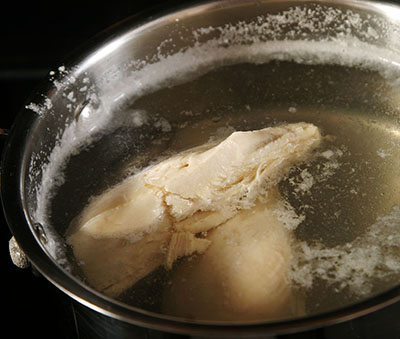
The roux is the backbone of gumbo. There are those who make a blond-roux gumbo, but most fans will toast the roux until it's very brown -- sometimes to the point where it's almost the color of chocolate syrup. This is a very delicate process, made even more so by the heat control required to pull this off. Like toasting almonds or spices, it will seize a moment of inattention by the cook and immediately cross over into a blackened, burned mess. It's not hard to do, though, if the cook is paying attention: * Use your wrist. Stir constantly, and in every corner, nook, and cranny of the pot. * Use your nose (but not too close -- it will spit occassionally). If it's getting too toasty, pull it off the heat. * Use your eyes. If parts of the roux are getting darker faster than others, and faster than you can stir it together, take it off the heat.
Normally for sauces, I make a butter roux, but for gumbo, I use vegetable oil -- olive oil and butter get weird-tasting at long exposures to heat. For this gumbo, I used 1/3 cup soybean oil, and 1/3rd cup unbleached flour. I adjusted the heat a lot between medium and medium-high, and from hot blond to this dark, it took about 15-20 minutes. The roux will go from white, to blond-yellow, to a reddish color, through mahogany, to a rich brown.




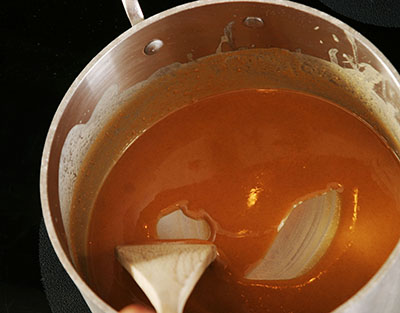

Once the roux hit the point where I got too nervous to continue, I immediately added the trinity and, a minute or two later, the sausage. This will spit a bit, and it's necessary to keep stirring everything together until the vegetables soften a bit, and the sausage looks nicely cooked. I added about a tablespoon to a tablespoon and a half of cajun seasoning (I use Emeril's Essence, but I use half the salt, and make it kosher to boot to cut the saltiness down even more). This is a personal taste thing -- it can get as spicy as you can take.
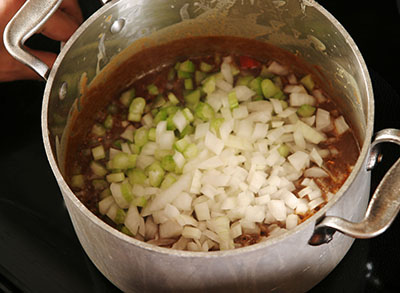


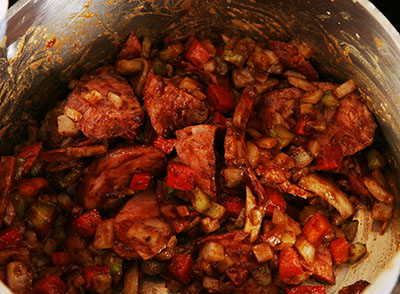
From here on out, gumbo is a personalized thing, and pretty easy. Ingredients are substituted left and right and it's still gumbo. Liquid is next -- I added some white wine to cool off the roux, stirred it in, then added a cup of chicken stock and a cup of shrimp stock. These were homemade stocks, but low-sodium canned chicken stock is acceptable, and some cooks just use water (you could use the strained poaching water from the chicken if there's not too much salt in it, or even toss the shrimp shells in the poaching liquid, simmer, and strain that into the roux, too. Flavor!)

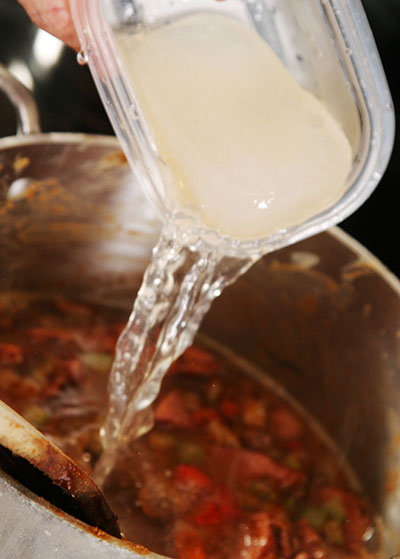
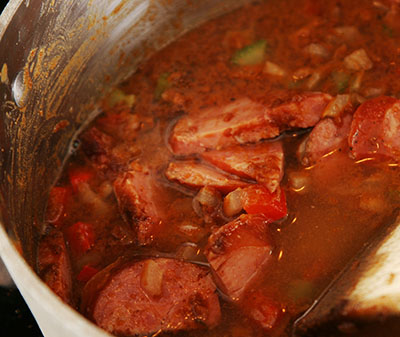
You can let this barely simmer for anywhere from 15 minutes to all day (replacing water as necessary). While it was simmering, I shredded the chicken with a couple forks. About 10 minutes before the gumbo was done, I added the peeled raw shrimp to the gumbo to poach/cook in the gumbo itself, and added the shredded chicken. Make sure the shrimp is completely buried in the gumbo to fully cook them.




About two minutes before serving, I added a teaspoon or two of file, which is sassafras leaves pounded in a giant mortar-like contraption until it is almost the consistency of dust. It's very fine and a small cloud always leaves the bottle when you open it. I stirred the file in to let the gumbo thicken. This seems almost counter-intuitive with 1/3 cup of roux in a couple cups of liquid, but the more a roux is toasted, the more it loses its thickening power. It needs a little help.

At the very last second, I squeeze in some lemon juice to brighten everything up a bit, then serve in a bowl with cooked white rice (I garnished with a shrimp still in the shell). You could dust this with some more file powder for taste, or some cajun spice for heat. Or, you could just grab a bowl and dig right in.


Deconstruction: You might be able to tell I really love gumbo. Nothing bugs me more than ordering gumbo in a restaurant and getting a blond, floury-starchy goop with seafood suspended inside something like jello. Nothing impresses me more than finding a place that serves a nutty-brown, stew-like, tender gumbo packing some serious heat -- okra or file, I don't care, as long as they know what they're doing. I haven't made this in a while, and there were a couple parts which I could have improved upon, but it was still mighty tasty. Plus, there is a wonderful smell in the house between the brown roux, the seared and softened trinity, and the poaching shrimp.



